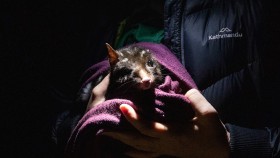Intimate private lives of blue whales revealed for the first time
Some of the first ever recorded evidence of reproduction in blue whales, including underwater footage of a mother nursing its calf, has been captured as part of a decade-long research and citizen science program led by The Australian National University (ANU).
The whales were spotted off the coast of Timor-Leste as part of the annual monitoring of the Austral-Indonesian population of pygmy blue whales. These whales travel more than 5,000
kilometres during their annual migration between southern Australia and the Banda Sea near eastern Indonesia via the waters of Timor-Leste.
Program leader and marine ecologist, ANU Associate Professor Karen Edyvane, who is also an Adjunct Senior Research Fellow at Charles Darwin University (CDU), has been conducting research in Timor-Leste since 2006 and said the blue whale’s reproductive and calving behaviour has remained largely unknown in the scientific community until now.
“Our decade-long project has documented some of the lesser-known intimate reproductive behaviours of blue whales, some for the very first time. It’s very exciting,” she said.
“From newborn calves and nursing mothers to amorous adults in courtship, the waters of Timor-Leste really are providing blue whale scientists with some of our first glimpses into the private lives of one of the world’s largest but most elusive animals.”
The research, presented for the first time to the Scientific Committee of the International Whaling Commission (IWC) back in April, draws on more than a decade of observations, surveys and monitoring datasets.
In 2008, surveys by Australian scientists, including Associate Professor Edyvane, around the coast of Timor-Leste identified the country’s waters as a global cetacean hotspot and a potential major migration corridor for whales and dolphins.

ANU Associate Professor Karen Edyvane says the program has sighted over 2,700 blue whales in Timor-Leste’s waters. Photo: supplied.
Associate Professor Edyvane said the latest findings not only confirm Timor-Leste’s waters as a major migration corridor for blue whales, but also an unprecedented location for blue whale research.
“Timor-Leste’s deep, nearshore waters, particularly in the narrow Ombai-Wetar Strait along the north coast of the country, provide one of the most accessible and best locations for blue whale research in the world,” she said.
“Since 2014, our program has sighted over 2,700 blue whales in Timor-Leste’s waters, monitoring their annual migration along the country’s north coast. On a global level, these numbers are truly extraordinary.”
Dr Elanor Bell, a researcher at the Australian Antarctic Division and an Australian government representative within the IWC’s Scientific Committee, said: “The long-term blue whale monitoring in Timor-Leste is providing hugely valuable insights into blue whale movements and behaviours in tropical waters and excited many whale experts at the recent IWC Scientific Committee meeting.”
“This evidence suggests that these waters are not only important foraging areas for blue whales, but also are critical for reproduction. Until now, it has been a mystery when, where and how blue whales reproduce.”
Research partner Jose Quintas, National Director for Environment and Research at the Timor-Leste government’s Ministry of Tourism, said Timor-Leste’s blue whale monitoring program, known locally as Baleia no Golfinhu iha Timor-Leste, has been a huge success due to its citizen science program and partnerships.
“Over the past decade, we’ve all shared a common purpose in finding out more about the pygmy blue whale migration to learn more about and protect Timor-Leste’s extraordinary ocean life but also to support the sustainability of our rapidly growing whale tourism industry,” he said.
“It’s really developed and grown into a major collaboration between researchers, whale tour operators and tourists, student volunteers and local fishermen – all sharing information, images and observations about blue whale sightings. They’ve shared with us some amazing blue whale images. It’s really been an exciting and shared journey.
“But now, we really need to use this valuable new information to ensure we fully protect and conserve these animals when they pass through Timor-Leste’s waters and beyond. For this, we urgently need cooperation and support from Australia and the wider international community.”









